Day 1 of a three day long weekend of tours today. The weather forecast was terrible – rain all day and strong winds. Thankfully, once again it was nowhere near as bad as forecast and we had a great day, with over 100 species of bird on the list already!
It was cloudy and spitting with light rain as we made our way west along the coast road. A Cuckoo flew out of the hedge and across the road, right in front of the car, luckily just avoiding us, before disappearing away over the fields. We were heading for Titchwell today, but took a short diversion inland to Choseley. There have been some Dotterel in the fields here in the last few days, something we were keen to see.
It was very wet underfoot, but thankfully not raining, as we made our way to the edge of the field where the Dotterel have been. As we scanned across the stony ground, we could see a few Red-legged Partridges. An Oystercatcher was sitting tight, possibly trying to nest. Then, much further down the field, we found a single Dotterel. We had a look at it in the scope, but it was distant, so we decided to walk down the footpath and have a look from the other end.
When we got to the end of the hedge and started to scan the field, we realised that the Dotterel was very close in front of us. It had sat itself down in among the emerging sugar beet seedlings and was quite hard to see at first, other than through the scope, until it finally stood up. It appeared to be a male, not as contrasting as a female with a streaked cap – the sexes are reversed in Dotterel, so the female is the brighter.
 Dotterel – the first we saw this morning, a male
Dotterel – the first we saw this morning, a male
We heard something calling behind us and turned to see another Dotterel flying in. It circled round and landed in the field, even closer to us than the one we had just been watching! Unfortunately, just at that moment, a large group of walkers were coming along the footpath and it took off again. As it did so, a third Dotterel flew in and joined it, and the two of them landed again further down the field.
These two Dotterel were females, so we decided to walk down along the footpath to try to get a better view of them. As we did so, a Corn Bunting flew up from the rough strip on the edge of the field and landed a bit further along, so we could get a look at it. There were a few Yellowhammers around the hedge as we walked along too. A Hobby came zipping in, low over the field behind us and disappeared back towards the barns.
The two female Dotterel were feeding actively, walking quickly along the field, in and out of the ruts, stopping every now and then to look round. We had a great view of them through the scope. We had been watching them for some time, when we noticed them stop and begin to call quietly. The next thing we noticed was another four Dotterel walking up the field towards them, all bright females again. The six of them gradually worked their way back over the field, so having enjoyed such fantastic views of them today, we decided to move on.
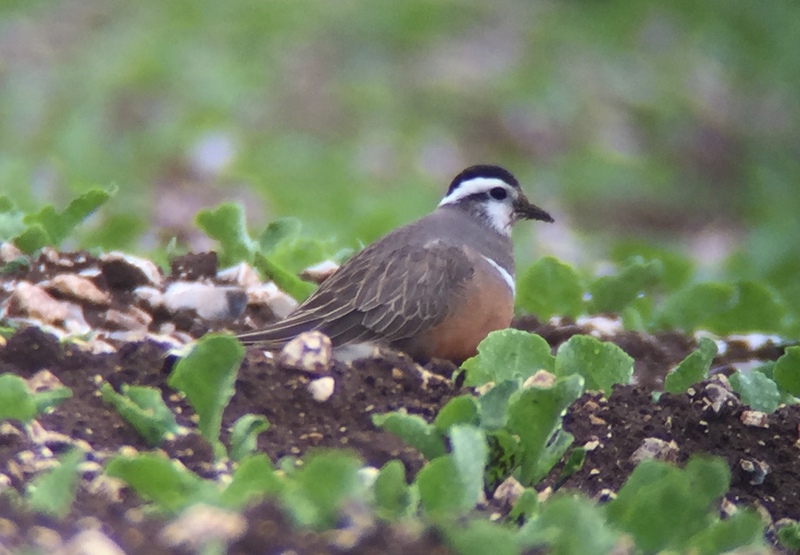 Dotterel – one of the six brighter females in the field today
Dotterel – one of the six brighter females in the field today
It was cool and damp when we got down to Titchwell but we could immediately hear a Turtle Dove purring quietly. It seemed to be coming from the direction of the overflow car park, but when we got there it had gone silent. We walked round quietly and found it hiding deep in one of the trees, but managed to find an angle from which we got an unrestricted view of it head on. Turtle Doves are such scarce birds these days, it is always a delight to see one.
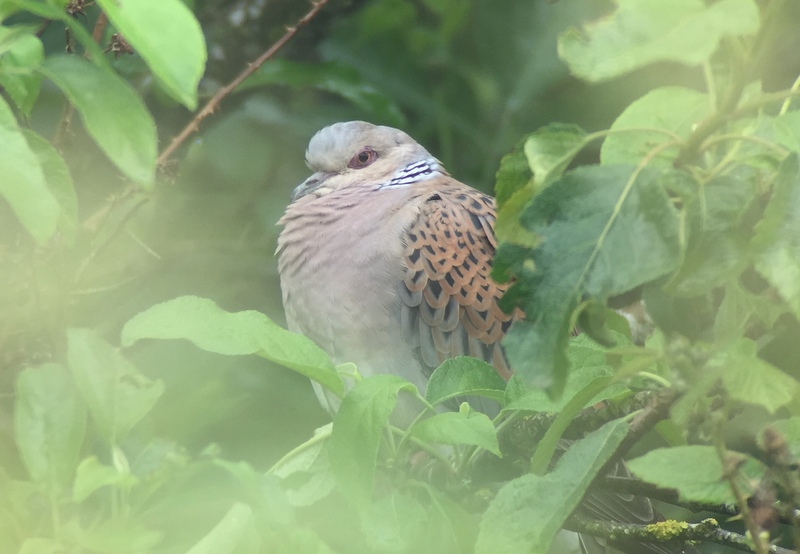 Turtle Dove – hiding in the bushes in the early rain
Turtle Dove – hiding in the bushes in the early rain
On the walk to the visitor centre, we could hear a Song Thrush singing, and eventually found it high in one of the trees next to the path. A Chiffchaff was singing from the sallows, doing a passable impression of its name. There were a few Chaffinches and Goldfinches on the feeders, although the ones the other side of the visitor centre were being monopolised by several Jackdaws.
Heading out along the main path, we came across a large flock of Long-tailed Tits, a family party with several sooty-faced juveniles. We could hear several Reed Warblers singing from the reedbed and stopped to watch a pair of them clambering around the edge of one of the pools, collecting nest material. A Cetti’s Warbler shouted from the bushes and we had a glimpse of it as it flew across the pool.
After the rain, the former Thornham grazing marsh pool had at least got a few puddles on it today, which were being occupied by several Shelduck. Several Swifts were hawking for insects over the reeds. There was not much of note on the reedbed pool, just a handful of Tufted Ducks, so we headed for the shelter of Island Hide, stopping briefly to look at a summer plumage Grey Plover on the saltmarsh.
There are a few more waders using the freshmarsh again, now that the water levels have started to drop. There was a nice flock of godwits roosting on the edge of one of the islands, a nice mixture of Black-tailed Godwits and Bar-tailed Godwits, the latter having presumably come in from the beach with the rising tide. Running around on the mud nearby, were several Sanderling, moulting into darker summer plumage now, and six black-bellied Dunlin. A flock of Turnstone flew in and whirled round over the islands, but didn’t stop. Over the other side, on the mud near Parrinder Hide, we could see at least three Ringed Plover and a single Little Ringed Plover.
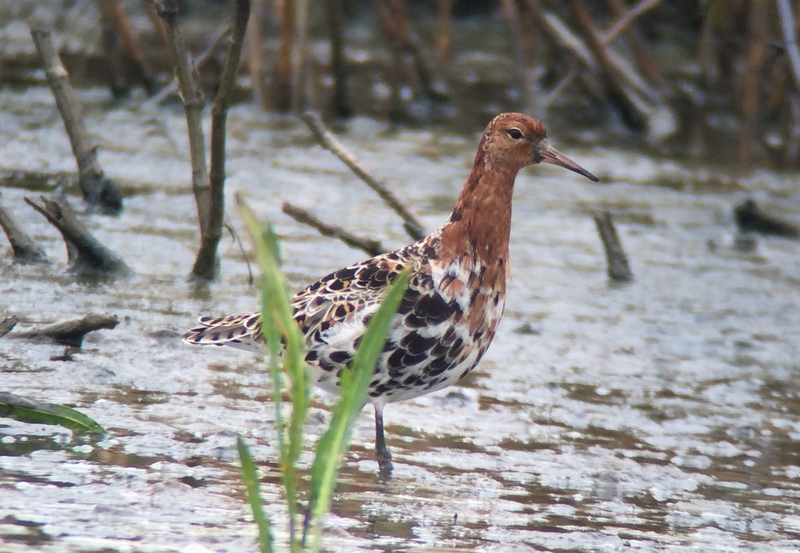 Ruff – a moulting male, with bright rusty head and neck
Ruff – a moulting male, with bright rusty head and neck
Needless to say, there is no shortage of Avocet here, although there were some nice ones feeding close in front of the hide. But it was the Ruff which stole the wader show. First, a rusty headed male Ruff appeared on the mud on the edge of the reeds. It was very striking, very brightly coloured but still moulting into breeding plumage and lacking the distinctive ‘ruff’.
When the godwit flock shuffled around and parted, we noticed a second Ruff in amongst them. Even though it was asleep, the wind was catching its feathers and we could see it had a full summer ‘ruff’. It was not as brightly coloured as the rusty-headed male, more subtly white barred with black, but when it woke up we could appreciate just how amazing its ‘ruff’ was. It started to feed and even raised its black crown feathers a couple of times, although it was a bit far away from where we were in Island Hide.
Many of the ducks have departed now, gone north for the breeding season – there were no Teal or Wigeon left here today. However, there are still plenty of Gadwall and Shelduck, plus a few Mallard and Shoveler. A pair of Gadwall feeding right in front of the hide gave us the opportunity to admire the intricacy of the drake’s patterning.
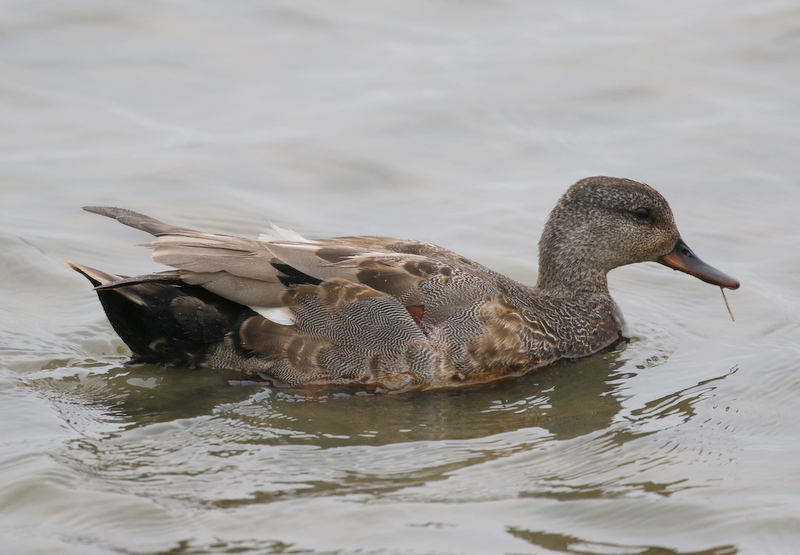 Gadwall – a beautifully patterned drake in front of Island Hide
Gadwall – a beautifully patterned drake in front of Island Hide
There were several Common Terns loafing around on the islands. The Black-headed Gulls have taken over the fenced off Avocet Island, and in alongst them we could make out a few Mediterranean Gulls too, blacker-headed and with brighter red bills and pure white wing tips.
There were lots of House Martins and a fair few Swallows too around the reserve today, presumably including many migrants which have stopped off on their way to try to find some food. As we walked round to Parrinder Hide, a group of them were hawking low up and down the water’s edge just below the bank.
We got a better view of the stunning male Ruff from Parrinder Hide, before it flew off to feed on the mud over the other side. The Little Ringed Plover appeared briefly on one of the islands, as did a single Ringed Plover, but neither stayed long enough for everyone to get a good look through the scope.
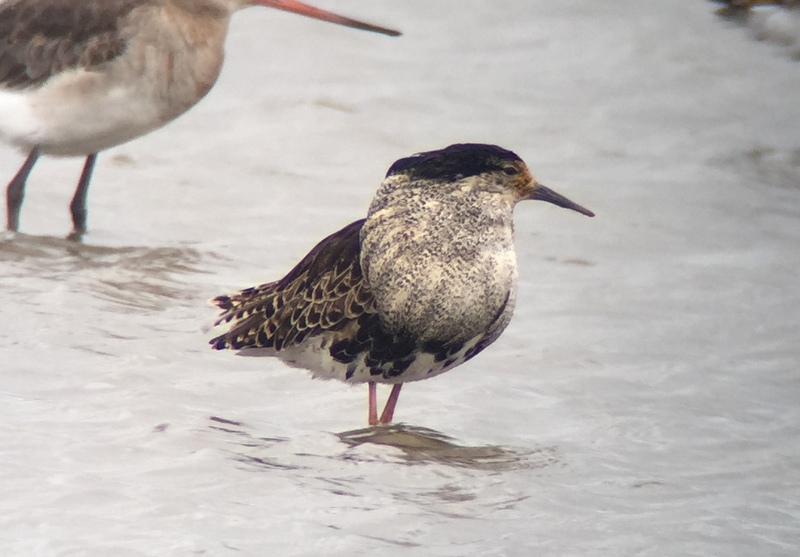 Ruff – in full breeding plumage, with black-barred white ruff and black crown
Ruff – in full breeding plumage, with black-barred white ruff and black crown
There was still some misty dampness in the air, but we decided to make a quick dash out to the beach. The Volunteer Marsh and Tidal Pools were both quiet today, as we passed and out at the sea, the tide was in. There was still a sizeable group of Oystercatchers gathered on the sand and a large flock of Sanderling whirled round over the beach and dropped down along the shore.
There are still quite a few seaduck here, but the sea was rough today, given the wind, and the scoter flocks were some way out. We did manage to find a distant group of Common Scoter which was still visible on the sea though. A couple of Fulmars flew past with barely a flew of their wings. It was not the weather to be standing around on the beach today, so we decided to head back.
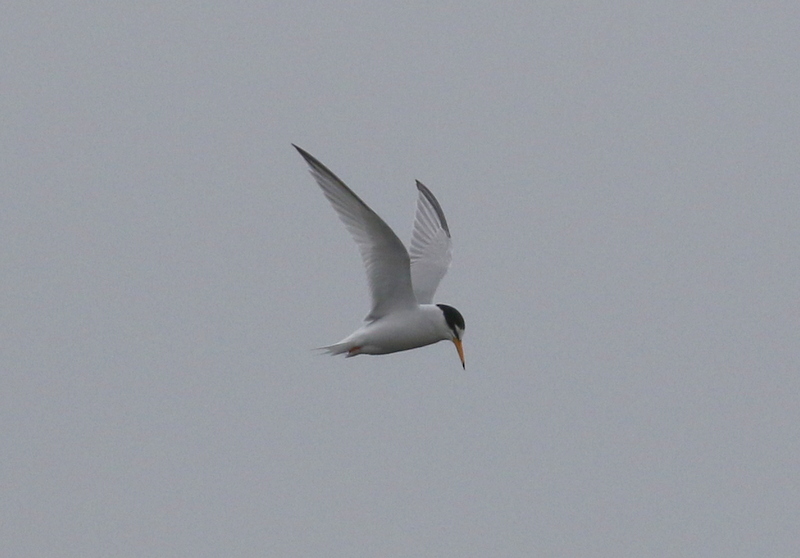 Little Tern – hovering over the Tidal Pools on our way back
Little Tern – hovering over the Tidal Pools on our way back
As we got over the dunes, a Little Tern was hovering along the edge of the Tidal Pools. Back at the reedbed, we heard a Bearded Tit calling and managed to catch a brief glimpse of a male which shot across the top of the reeds carrying food, although it was too quick for most of the group to get onto. Two gaudy drake Red-crested Pochard had appeared at the back of the reedbed pool.
There seemed to be even more Swifts around on the way back – small groups appeared to be moving through, while others were gathering to feed. We bumped into one of the locals who told us that he had seen a Spotted Flycatcher by the dragonfly pool, so we swung round via the Meadow Trail, but there was no sign of it when we arrived. A Little Grebe was diving out on the water, a pair of Reed Warblers were chasing around in the reeds nearby and a Red Kite circled overhead.
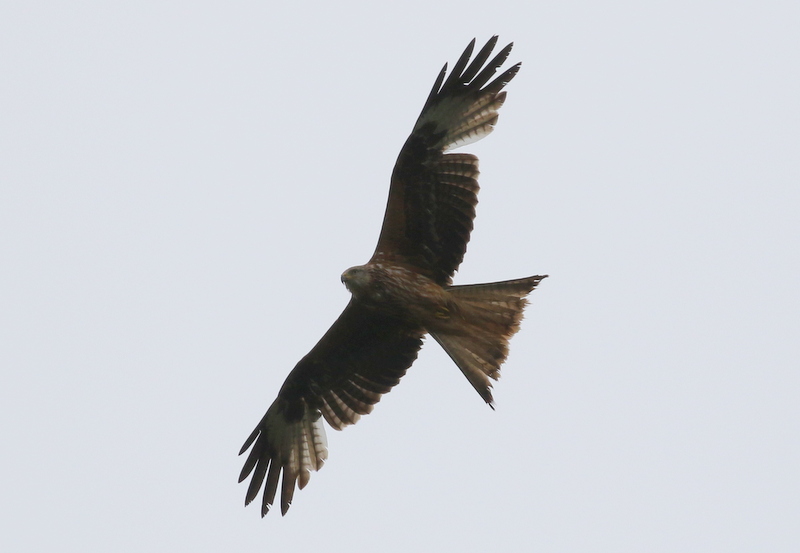 Red Kite – circled over Meadow Trail
Red Kite – circled over Meadow Trail
After lunch back at the visitor centre and a very welcome warming hot drink, we walked round to Patsy’s Reedbed. A Great Crested Grebe was looking particularly resplendent in its breeding finery. Several drake Common Pochard were asleep around the edge and a single hybrid Pochard x Tufted Duck was diving out on the water. There were lots of Swifts, Swallows and House Martins hawking for insects low over the water here too now.
A quick look over the hedge in the horse paddocks paid dividends, with a single female Yellow Wagtail feeding on the short grass with three Pied Wagtails.
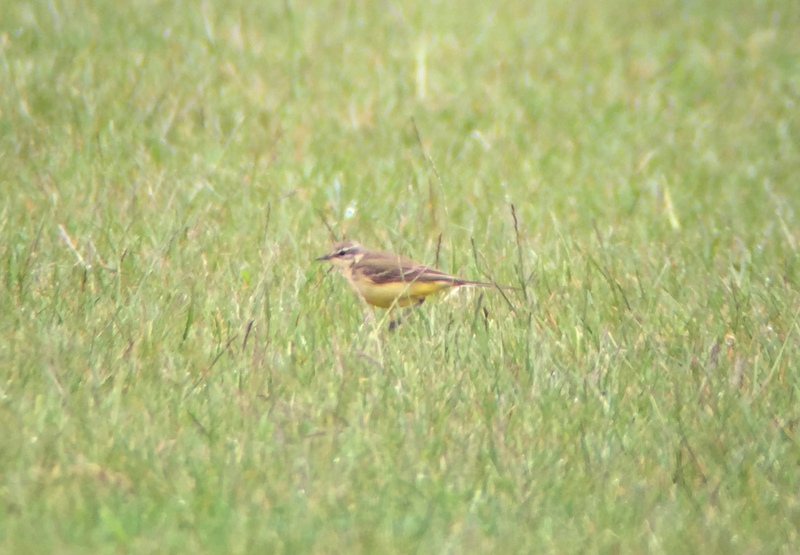 Yellow Wagtail – a female, feeding in the horse paddocks behind Patsy’s Reedbed
Yellow Wagtail – a female, feeding in the horse paddocks behind Patsy’s Reedbed
There were several Marsh Harriers circling over the reedbed and we watched a male come in over the paddocks from the fields beyond, carrying something in its talons. As it approached the reeds, a female Marsh Harrier circled up and started calling, at which point the male dropped the food it had brought and the female caught it in mid air – a ‘food pass’.
 Marsh Harrier – several were flying round over the reeds, including this male
Marsh Harrier – several were flying round over the reeds, including this male
Back at the car park, the Turtle Dove was purring more actively now that the weather had brightened up. We got a great look at it, perched in the top of a dead tree. Then we set off to drive round to Thornham Harbour.
On our way down the road to the harbour, a ghostly white shape suddenly appeared from behind the hedge and drifted across the road in front of us, a Barn Owl. As if by coincidence, one of the group had asked not half an hour earlier whether there was any chance of seeing one this weekend, and we had discussed how the overnight rain last night meant their had to be a possibility one would be out hunting. As if by magic!
We turned round and drove into the pub car park. The Barn Owl was now hunting over the meadow just beyond and we had a great view of it as it worked its way round over the grass. After a few minutes, it dropped down to the ground out of view. When it came up again, we could see it had a large vole in its bill. It flew up over the hedge and disappeared off carrying it, presumably off to feed its hungry brood nearby.
 Barn Owl – out hunting early this afternoon, after a wet night overnight
Barn Owl – out hunting early this afternoon, after a wet night overnight
From up in the harbour car park, we could see there were still lots of Brent Geese out on the saltmarsh and sandbanks. Most of the Brent Geese which spent the winter here have already departed back to Russia, and presumably most of these lingering birds should be on their way as well soon. There were also quite a few striking Grey Plovers, with their black faces and bellies now.
We walked up onto the seawall, from where we could get an even better view over the harbour. In the distance, beyond the Brent Geese, we could see three Eider asleep on the sand. They were all young drakes, 1st summers, so have not headed north this year to breed. As we walked along the bank, a female Wheatear flew off ahead of us, flashing its white rump, before landing in a Suaeda bush. Away over the grazing marshes, we could hear a Cuckoo singing in the distance.
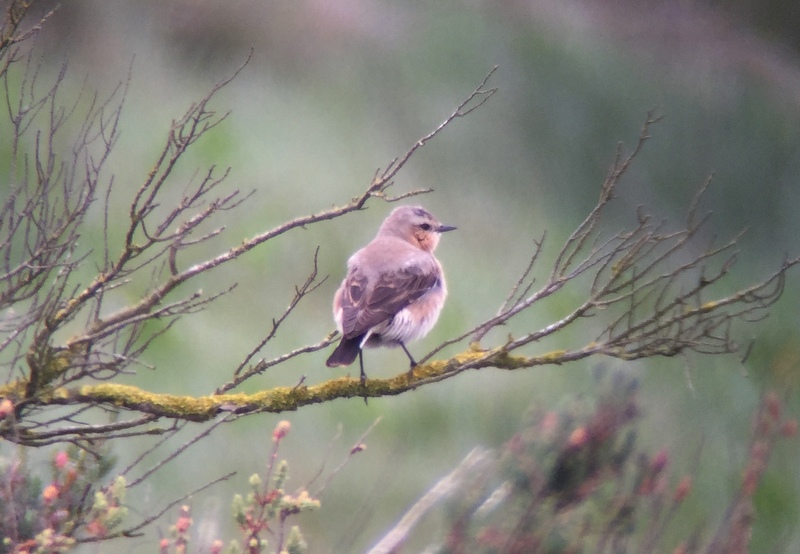 Wheatear – a female, along the seawall at Thornham Harbour
Wheatear – a female, along the seawall at Thornham Harbour
As we made our way back east along the coast, we headed off inland to see if we could add to our tally of farmland birds. Another Red Kite circled over a field. We could see a pair of Grey Partridge in the distance. A Tawny Owl hooted unseen from a wood. And there were lots of Brown Hares in the fields.
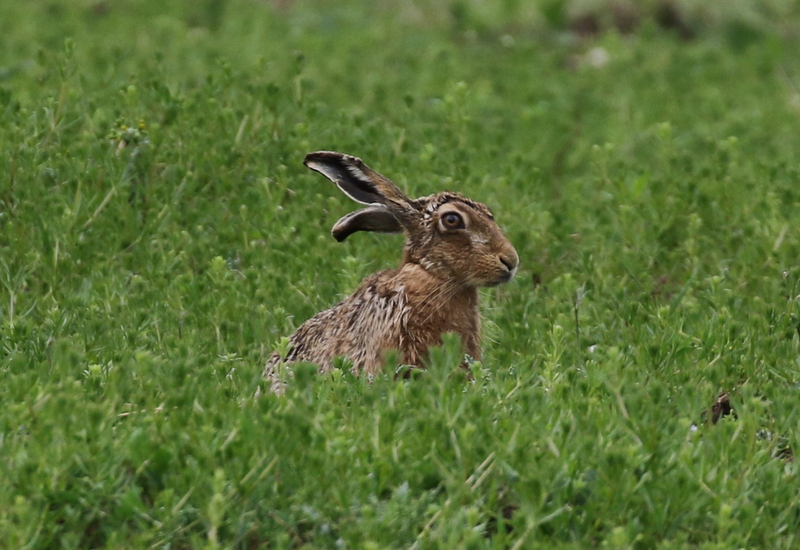 Brown Hare – we saw lots in the fields today
Brown Hare – we saw lots in the fields today
Our final stop of the day was at Holkham. We didn’t have enough time to explore the reserve today, but we stopped at a convenient vantage point overlooking the grazing marshes. A Great White Egret appeared from a ditch, its size obvious even at distance. A second Great White Egret was hiding in a patch of reeds over the other side. A steady stream of Spoonbills was coming and going, but down in the trees we could see three white shapes perched up in the tops. Through the scope, we could see two well-grown juvenile Spoonbills, together with an adult.
There is no shortage of Greylag Geese here at this time of year, and a fair few Canada Geese too. Almost all of the Pink-footed Geese which were here over the winter have departed, back to Iceland for the breeding season, but a very small number remain through the summer, mainly injured or sick birds. We could see two Pink-footed Geese asleep in the grass today, one of which had a damaged wing, presumably having been shot and wounded.
Barn Owls are much like buses, as having already seen one at Thornham earlier, a second now appeared, hunting over the grazing marshes here.It spent some time flying round, covering quite a large area, before the next thing we knew, we saw it heading off purposefully with something in its talons. We watched it fly all the way off towards some distant outbuildings, preumably where it had its hungry brood waiting. Then it was time for us to head off home too.
















